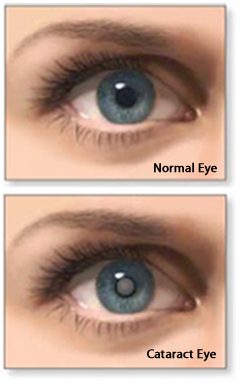How Can Cataract Surgery Help You?
 Cataracts are a natural aging process of the eye. By the age of 65 about half of all Americans have developed some degree of a cataract. Most people believe a cataract is a film that grows on the surface of the eye, but in actuality it’s the clouding of the natural lens. Over time and with age, the lens becomes cloudy, causing images to look blurred or fuzzy. At the beginning phrases of a cataract development all that is needed to correct the blurred vision is a pair of glasses or a new prescription. If you experience clouded vision, fading or yellowing of colors, double vision in a single eye, difficulty seeing at night, halos around light or frequent changes in eyeglass prescription, a cataract may have developed in one or both or your eyes.
Cataracts are a natural aging process of the eye. By the age of 65 about half of all Americans have developed some degree of a cataract. Most people believe a cataract is a film that grows on the surface of the eye, but in actuality it’s the clouding of the natural lens. Over time and with age, the lens becomes cloudy, causing images to look blurred or fuzzy. At the beginning phrases of a cataract development all that is needed to correct the blurred vision is a pair of glasses or a new prescription. If you experience clouded vision, fading or yellowing of colors, double vision in a single eye, difficulty seeing at night, halos around light or frequent changes in eyeglass prescription, a cataract may have developed in one or both or your eyes.
If the cataract causes bothersome vision problems and interferes with your daily routine, your ophthalmologist may recommend undergoing surgery to have it removed.
How Can Cataract Surgery Help You?
Today, modern cataract surgery is one of the safest and most successful procedures. The surgery provides patients with both clarity and color of vision, increased independence, an improved quality of life and less dependence on corrective eyewear. Cataract surgery is permanent. In other words, it is impossible for a cataract to come back, because the lens of the eye, where the cataracts grows has been replaced with a new lens that will last a lifetime. During the surgery, the lens in your eye that has become cloudy is removed and replaced with an artificial lens or an IOL to restore clear vision. Your eye doctor will help you choose which IOL is the right fit for you.
What Types of Cataract Surgeries are Available?
Custom Laser Cataract Surgery with LenSx Procedure- The FDA has approved laser cataract surgery as both safe and effect. It works by using optical coherence tomography (OCT) with near infrared light, to produce a digital analysis and computer driven femtosecond laser application. All of the eye structures are displayed in (3D) digital representation continuously, which provides 3D mapping, enabling exact placement within the eye for precise laser application. Doctors can customize the procedure to your unique visual needs to result in better visual outcomes.
Refractive Cataract Surgery- An additional level of care that brings together the latest technology in eye surgeries to help obtain the best possible vision. Refractive cataract surgery can be customized specifically to correct nearsightedness, farsightedness, astigmatism and the reflective aging changes that happen in your eye, all done with the precision of laser.
All eye surgeries are done on-campus in the Rand Surgical Pavillion, a state-of-the-art surgical facility approved by the State of Florida Health Care Administration.
Age-Related Vision Problems
As you age, so do your eyes. You might have trouble reading fine print or need brighter lights in your workspace. Some age-related eye changes are very common and do not signify any sort of disease. Other changes, although still common among senior citizens, can indicate a problem.
1. A cataract is a clouding of the lens, a transparent, layered structure that is found behind the iris. A cataract may begin to form as early as the age of 40 or 50 and can go unnoticed. By 60, the cataract may have advanced enough to cause lower vision. In most cases, people with cataracts can undergo surgical treatment to restore adequate vision.
2. Age-related-macular degeneration destroys the macula, which is a cluster of light-sensitive cells in the center of the retina. The macula is responsible for crisp vision and fine perception of detail. Over 15 million Americans have AMD and it is the leading cause for low vision in those over age 60. Early diagnosis and follow-up appointments with your doctor are essential for preserving vision in people with AMD.
3. Glaucoma is a group of diseases in which the optic nerve begins to damage due to excessive fluid pressure in the eyeball. In people with open-angle glaucoma, the most common type, fluid drainage fails to keep pace with the output. Then, pressure builds on the optic nerve as fluid levels continue to rise. This process occurs so gradually that it may only be noticeable once vision loss has occurred. In some cases, the optic nerve can become so damaged that it is unable to send complete signals to the brain. Those over 60 are at a greater risk for developing glaucoma. Treatment includes medication, laser therapy or surgery.
4. Diabetic Retinopathy is the most common diabetic eye disease and contributes to the leading cause of blindness in elderly Americans. In some people with diabetic retinopathy, blood vessels swell and leak fluid. In other cases, new vessels may grow on the surface of the retina. At first, the changes can go unnoticed, but over time diabetic retinopathy can worsen, causing vision loss. Diabetic retinopathy usually affects both eyes.
5. Presbyopia refers to the farsightedness that develops when the lens of the eye and its surrounding muscles lose their elasticity, causing the muscle fibers to become too rigid to contract or relax properly. As a result, they can no longer focus light well enough to produce clear and crisp vision images. This condition can easily be corrected with reading glasses, bi- or trifocals, contact lenses or surgery.
6. Ptosis describes the droopy, hooded eyelid characteristics that occur with aging. If the drooping becomes too extreme that it causes obscure vision, surgery can be considered.
Rand Eye Institute can assist you in delaying these problems and find the right solution for you.
Keep Your Eyes Young
No one wants to wake up one morning to find wrinkles or bags around their eyes when looking in the mirror. Signs of aging catch most people off guard and before they know it, it’s too late. While you’re attempting to keep your skin looking fresh and radiant with creams and treatments, why not keep your eyes looking young also?
The skin closest to the eye is very sensitive and can easily be affected by one’s lifestyle. Collagen is the protein that maintains the skins firmness and keeps it plump. Cortisol, a hormone released from stress, creates loss of collagen, and the skin in turn thins out. Some signs of aging include crow’s feet, crepe-y eyelids, and dark circles and there are several ways to prevent these changes. The key to keeping the wrinkles and circles away is to follow proper defense mechanisms for the eyes.

• Get at least 8 hours of sleep every night
• Be gentle when applying and removing makeup
• Wear sunglasses to keep you from squinting
• De-stress and find time to relax
• Use hydrating moisturizer with antioxidants
Custom Laser Cataract Surgery
While cataract surgery has been one of the safest and most successful operations, this bladeless, advanced procedure, brings a new level of precision to the surgery, creating a personalized surgical experience. It is a major improvement in the ability to treat astigmatism more accurately.
Wishing Everyone Happy Holidays and a Happy New Year
From the sunny weather in South Florida, the Rand Eye Institute would like to wish you Happy Holidays and a Happy New Year!


